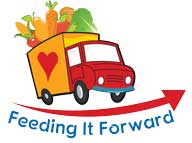About Feeding It Forward
Feeding It Forward works to reduce waste and alleviate hunger in Napa County through collaborative efforts. We rescue excess fresh food from donors and deliver it to organizations fighting hunger in our community.
Goal #1
Implement a prepared food recovery system to ensure sustainability and efficiency, matching donations with the needs of our communities.
Goal #2
Work collaboratively to reduce and hopefully eliminate food insecurity while reducing waste.
We are a compassionate group of volunteers who are passionate about recovering excess food in our communities and reducing food waste.
Below are some of the reasons we are so passionate:
Health and Related Societal Cost
Poverty and food insecurity are social determinants of health and are associated with some of the most serious and costly health problems in our nation.
Children
While food insecurity has direct and indirect impacts on physical and mental health for people of all ages, food insecurity is especially detrimental to the health, development, and well-being of children in the short and long term.
Youth
Food insecurity is related to poor child health and well-being. It is related to increased hospitalizations, poor child development, poor school performance, and suicidal ideation among children. However, what is forgotten is that a child’s illness affects the family’s balance and triggers coping mechanisms.
Adults
For working-age adults, living with lower food security is associated with higher probability of chronic diseases.
Seniors
Food-insecure elderly were 2.3 times more likely to report fair or poor health status and had higher nutritional risk.
In general, one out of three chronically ill adults are unable to afford medicine, food, or both.
Community
Research shows that household food insecurity is a strong predictor of higher health care utilization and increased health care costs.
Environmental Cost
The need to reduce food waste has never been greater. Reducing food waste in the U.S. can deliver significant environmental, social, and economic benefits.
Amount of Food Waste
In the U.S., food waste is estimated at between 30% and 40% of the food supply. This amount of waste has far-reaching impacts on food security, resource conservation, and climate change.
The EPA estimates that more food reaches landfills and incinerators than any other single material in our everyday trash, constituting 21.6% of discarded municipal solid waste.
Methane Generation
Food waste is the single largest waste component going into municipal landfills.
When food waste decomposes in a landfill, it generates methane, a potent greenhouse gas with 21 times the global warming potential of carbon dioxide. In fact, landfills are responsible for one-third of all methane emissions in the United States. Keeping food waste out of landfills will result in reduced methane emissions.
Wasted Resources
The land, water, labor, energy, and other inputs used in producing, processing, transporting, preparing, storing, and disposing of discarded food are pulled away from uses that may have been more beneficial to society. This generates impacts on the environment that may endanger the long-run health of the planet. Wasted food is a waste of resources!
Some Wasted Food Is Rescuable
Some of the food waste generated in the U.S. is actually not waste at all, as it is safe to eat and nutritious. In these instances, the food can be donated to food banks and other hunger-fighting organizations, thereby keeping it out of landfills while helping those in need.
Rescued Food's Potential
Wholesome food that could help feed families in need is instead sent to landfills. This could be rescued, thereby reducing food insecurity.
What Is Food Insecurity?
Food insecurity is the state of being without reliable access to a sufficient quantity of affordable, nutritious food.
People experiencing food insecurity often consume a nutrient-poor diet, which may contribute to the development of obesity, heart disease, hypertension, diabetes, and other chronic diseases.
Who Faces Food Insecurity in Napa County?
6,000+ children
Over 6,000 children (19%) in Napa County are food insecure.
Adults 65 years and older
Our county has 20,125 seniors, with 6% living below the federal poverty level.
All residents
A total of 10% of our residents are below the federal poverty level.
